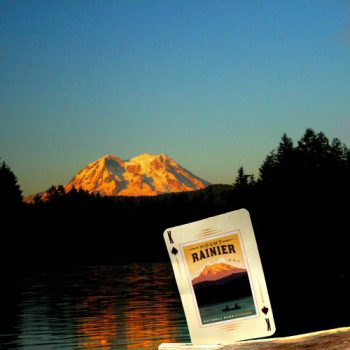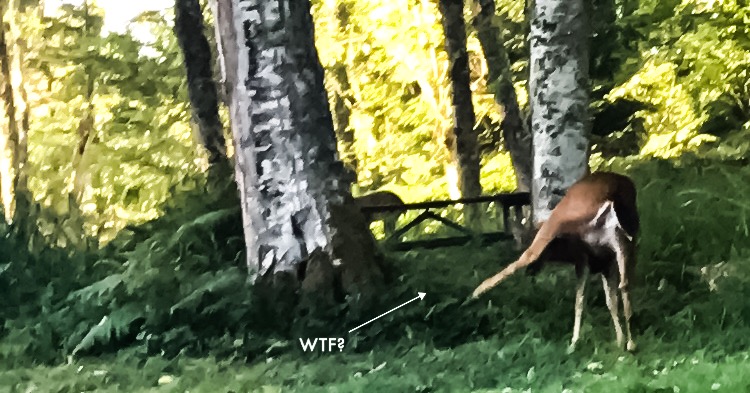
North Cascades & Mount Rainier National Parks
North Cascades & Mount Rainier National Parks
I safely escaped Forks, Washington free of any fang marks, stashed the Ruck Rig at Alder Lake in the middle of Washington and made my way North and East towards North Cascades National Park. Mount Rainier drew my gaze as it loomed over the landscape for a bit, then shrunk into the growing distance behind me. My reasoning for including both parks in a single entry is two-fold. First, both parks are part of the North Cascades range, the most rugged mountain range in the Country. Some call it the American Alps and it was the last American range to be explored in the Lower 48, due to its treacherous and inhospitable nature. Rainier, however, was big enough, far enough way, and absent topographic competition, subsequently earning its own park designation almost seventy years before North Cascades. Second, I grossly underestimated the potential of North Cascades and spent the majority of time on the road rather than on the trail so much remains a mouth-watering mystery. I will certainly be back. The park resembles Glacier National Park in many ways, although much less tourism development is evident. One could easily describe it metaphorically as the younger, meaner, unbridled brother of Glacier. Like Glacier, a single road intersects the park creating a massive area accessible only by foot or climbing. The peaks and valleys are extreme. The flora and fauna are similar as are the numerous ecosystems found throughout both regions. The mountain ranges of both parks overlap with Canada and are covered in glaciers and sparkling lakes of pristine melt. I spent three weeks in Glacier and covered a fraction. I spent three hours in North Cascades and couldn’t even intersect the park. With the eclipse quickly approaching, I needed a couple of weeks to find a suitable location in Oregon and time was getting tight and North Cascades was the unfortunate sacrifice. What I did get to see was incredible. It was rugged. It looked ominous and raw. This park could present a challenge to the best of hikers and peak baggers. The drawback to the area was the large amount of hydro-power infrastructure. It is unamusingly ironic that green energy is so damn ugly and completely changed the visible landscape in the vehicularly-accessible areas. Wires and scaffold towers peppered the ridgelines separating the views of visitors who stick to the road from some of the deepest, undeveloped solitude in the Nation a developed ridgeline beyond. It was beautiful scenery despite the spans. I grabbed a few shots along the route and declared the excursion a half-assed reconnoiter for future treks in bad-assery as I found my way back into some pretty awful Washington traffic. Not unlike Denver, Seattle sprawl wreaks havoc on the roadway travel times. It took hours to get back to Alder Lake but I had the majestic Mount Rainier to keep me company along the way.
It would be difficult to visit very many places in the State of Washington and not be familiar with Mount Rainier, the Nation’s 5th designated National Park. The 14,410-foot monolithic stratovolcano juts from near center of the State and dominates the horizon. Various awe-striking perspectives can be observed from every cardinal direction and I could see it easily from as far as Larch Mountain, South of the Columbia River Gorge in Oregon. It is simply a very large mountain with very little competition for horizon-line real estate. It lies at the end of the Cascade Range and holds the title of the highest in the range as well as the State. It is one of the Countries most prominent topographically and holds the most glaciated ice of all the peaks in the lower 48. Not much can touch Alaska, even the great Takoma. That’s right, the colossal heap of stone has not always been known as Rainier, the Euro-Canadian honorific given by George Vancouver. The prior inhabitants, comprised of numerous Pacific Northwest tribes such as the Puyallup and Nisqually, referred to the monument by many names: Talol, Tacoma, Tacobeh, & Pooskaus and more, most simply indicating, in respective vernacular, that it is “Larger” (ta) than “Mount Baker” (Koma), the North Cascades region’s tallest peak. A logical and reasonable title it would have seemed to begin with. Mount Denali, previously known as Mount McKinley, previously known as Mount Denali, went through the same growing pains before recognition was returned to the designation of the original inhabitants. Fair enough, perhaps. But I suspect that much more than a name changed after Euro-American settlement in the 1800’s. Men and their mountain names and land claims. Silly little power-people proclaiming it theirs as if it was put there to honor their greatness or is something to keep or carry with them in perpetuity because they set foot upon it. We all see presently, that namesake monuments have a way of changing face in pace with the creation of new histories and while National Park names are mostly benign or feature related. Not Rainier. I am sure he was a fine man although I know nothing of his legacy…perhaps he was tall. It is not likely I will get too comfortable with the present name in any case…Which mountain? The big one over there would certainly suffice. Besides, the mountain itself may or may not surpass the memory of its Eponym. Rainier happens to be one massive volcano long overdue a good venting. What then? Caldera Rainier? Positioned within the Pacific Ring of Fire, Rainier is dormant but far from extinct and the last eruption was in the 1800s. As recently as 35 years ago, Mount Saint Helens, also in the ring and visible from Rainier, blew its top. One of the greatest dangers of a modern eruption of Rainier would be that of Lahars, or volcanic mudflows, created by massive heat, debris, glacial ice and lava flow. Evidence reveals past Lahars reach as far as the ocean. Oddly, about one-hundred and fifty thousand people live on old Lahars and many are suggested to be unaware of the catastrophic phenomenon and lie directly in a known path. Here’s to hopin’, right!?!
I was able take in a complete 360-degree perspective of the giant plot of rock over the course of several weeks in the region. I frequently heard that it is a beautiful mountain with the caveat, when you can see it. But this was not my experience at all. With no rainfall for fifty-one days, nary a cloud polluted the sky when I caught my first glance of the peak from the East not long after crossing from Idaho into Washington along Interstate 90. It revealed itself again from the West as I returned to Seattle from the Olympic Peninsula. My return from North Cascades reflected the North face and Alder Lake and Eatonville afforded Southern exposures. Within the National Park boundaries is Paradise Inn which boasted the most spectacular picture window views nearest to the base along an adjacent mountain however parking was inadequate enough to warrant digital signs everywhere indicating the lot was full. I didn’t have to get that far to get some pretty stellar views. The closer you got to the mountain, however, the less manageable viewing and photographing it became. It is a very different experience up close compared to a distant iconic backdrop in the horizon. The nearer I came to the base, the more I realized how massive and extreme the colossus is. I bounced from turn out to turn out snapping various perspectives and captured a few time-lapse shots of some of the only cloud cover I encountered. Each evening and morning, I would walk down to Alder lake and take in the sunrise and sunset as it cast light and shadow on a clear, tree-framed view of the mountain miles away so well positioned, it almost appeared deliberate or manmade. Several black-tail deer crossed paths with me each morning and while we both observed one another, each were contented with the peaceful stillness of the morning in the company of biological strangers as I took in the scenery while they chewed on the sweet grasses of the lake’s edge. I wondered to myself if they ever just came for the view too…
Ruck Out…

Anyone care to explain to me what exactly is happening here?

John
He’s letting you know you’re in his territory.